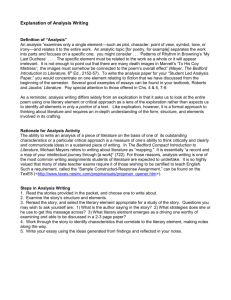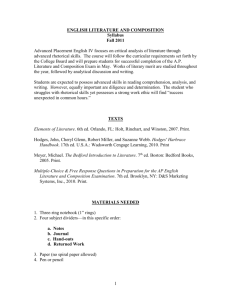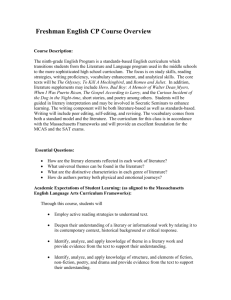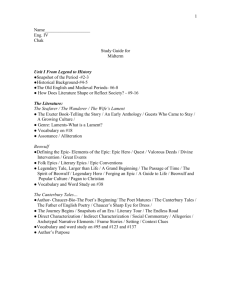English IV A
advertisement
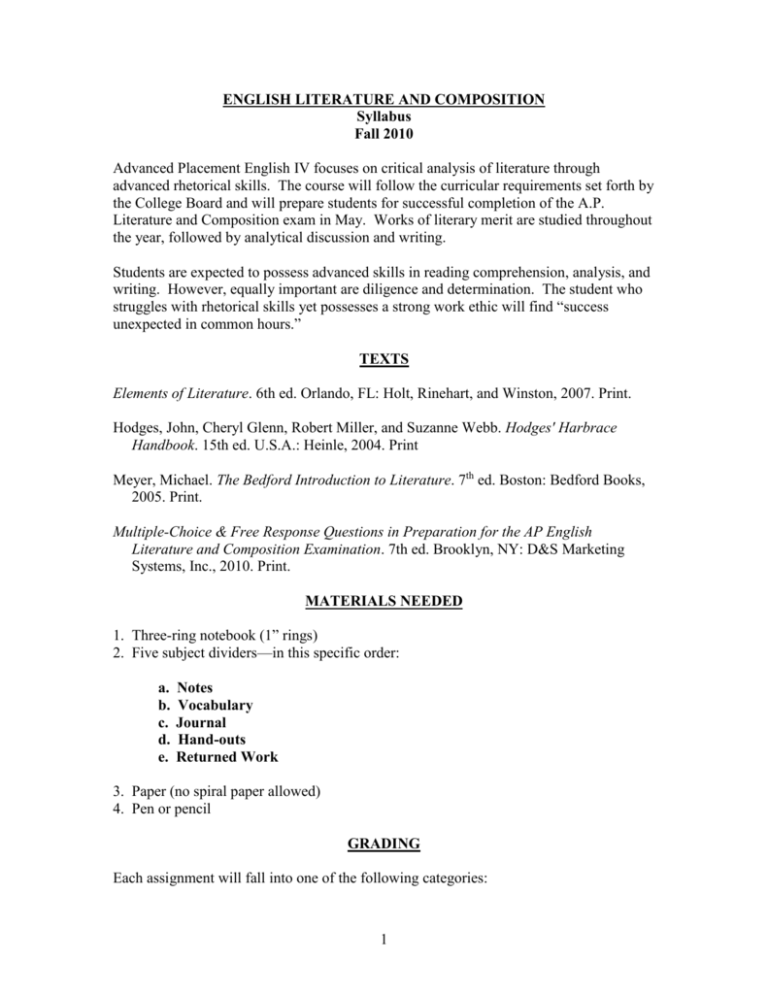
ENGLISH LITERATURE AND COMPOSITION Syllabus Fall 2010 Advanced Placement English IV focuses on critical analysis of literature through advanced rhetorical skills. The course will follow the curricular requirements set forth by the College Board and will prepare students for successful completion of the A.P. Literature and Composition exam in May. Works of literary merit are studied throughout the year, followed by analytical discussion and writing. Students are expected to possess advanced skills in reading comprehension, analysis, and writing. However, equally important are diligence and determination. The student who struggles with rhetorical skills yet possesses a strong work ethic will find “success unexpected in common hours.” TEXTS Elements of Literature. 6th ed. Orlando, FL: Holt, Rinehart, and Winston, 2007. Print. Hodges, John, Cheryl Glenn, Robert Miller, and Suzanne Webb. Hodges' Harbrace Handbook. 15th ed. U.S.A.: Heinle, 2004. Print Meyer, Michael. The Bedford Introduction to Literature. 7th ed. Boston: Bedford Books, 2005. Print. Multiple-Choice & Free Response Questions in Preparation for the AP English Literature and Composition Examination. 7th ed. Brooklyn, NY: D&S Marketing Systems, Inc., 2010. Print. MATERIALS NEEDED 1. Three-ring notebook (1” rings) 2. Five subject dividers—in this specific order: a. b. c. d. e. Notes Vocabulary Journal Hand-outs Returned Work 3. Paper (no spiral paper allowed) 4. Pen or pencil GRADING Each assignment will fall into one of the following categories: 1 Course Work Percent of Final Grade Category 1: Timed essays, writing process essays, tests, creative group projects......70% Category 2: Quizzes, notebook grade...........................................................................20% Category 3: Journal writing, completion assignments.................................................10% LATE WORK POLICY Late work will be penalized 25 points for each school day that it is late. FINAL EXAM POLICY In addition to the school policy, if you miss 10 or more of my classes due to field trips or other school-related activities, you will take my final exam. This is completely independent of your usual absences (e.g., illness, death in the family, etc.). SCOPE AND SEQUENCE This is a tentative syllabus and is subject to change as the year progresses. The primary focus of each literary unit is the major work (e.g., novel or play). The poems and short stories presented below will be selected as time permits. Unit 1 I. Literary Period: “The Anglo-Saxons” (449 A.D.—1066 A.D.) a. Introduction to the Literary Period (pp. 2-17) b. Major work: Beowulf (c. 700 A.D.) II. Poetry Each poem will be studied and analyzed for its specific emphasis on the following literary devices: (1) word choice, word order and tone (2) imagery (3) figures of speech (4) symbolism, allegory, and irony and (5) patterns of rhythm. In the study of these poems, the student will write extended, detailed, analyses using the TP-CASTT form. 2 Randall Jarrell, “The Death of the Ball Turret Runner,” p. 758; Jeanette Barnes, “Battle-Piece,” p. 792; Margaret Atwood, “You Fit into Me,” p. 817; Robert Frost, “Acquainted with the Night,” p. 838; Walt Whitman, “Song of the Open Road,” p. 892. III. Short Stories Each short story will be studied and analyzed for its specific emphasis on the following elements of literature: (1) plot (2) characterization (3) setting (4) point-of view (5) symbolism (6) theme (7) style, tone and irony Joyce Carol Oates, “Three Girls,” p. 74; May-Lee Chai, “Saving Sourdi,” p. 121; Ernest Hemingway, “Soldier’s Home,” p. 170; Anton Chekov, “The Lady with the Pet Dog,” p. 225; Chitra Banerjee Divakaruni, “Clothes,” p. 250; Stephen Crane, “The Bride Comes to the Yellow Sky,” p. 285; T. Coraghessan Boyle, “Carnal Knowledge,” p. 324. Unit 2 I. Literary Period: “The Middle Ages” (1066—1485) a. Introduction to the Literary Period (pp. 112-129) b. Major work: The Canterbury Tales (late 1300s) II. Poetry E.E. Cummings, “she being Brand,” p. 760; Walt Whitman, “Cavalry Crossing a Ford,” p. 793; Emily Dickinson, “Presentiment—is that long Shadow—on the lawn--,” p. 818; Edgar Allan Poe, “The Haunted Palace,” p. 840; William Wordsworth, “My Heart Leaps Up,” p. 895. III. Short Stories Stephen King, “All That You Love Will Be Carried Away,” p. 81; Herman Melville, “Bartleby the Scrivener,” p. 135; Andrea Lee, “Anthropology,” p. 177; Joyce Carol Oates, “The Lady with the Pet Dog,” p. 227; Collette, “The Hand,” p. 259; Katherine Mansfield, “Miss Brill,” p. 295; Susan Minot, “Lust,” p. 339. 3 Unit 3 I. Literary Period: “The Renaissance” (1485-1660) a. Introduction to the Literary Period (pp. 270-290) b. Major works: 1. Hamlet (1599) 2. Macbeth (1603) II. Poetry From Bedford: Judith Ortiz Cofer, “Common Ground,” p. 762; David Soloway, “Windsurfing,” p. 793; Anne Bradstreet, “The Author to Her Book,” p. 819; Edward Arlington Robinson, “Richard Cory,” p. 842; Timothy Steele, “Waiting for the Storm,”p. 897. From Elements of Literature: William Shakespeare, “Sonnet 18,” “Sonnet 29,” “Sonnet 30,” Sonnet “71,” “Sonnet 73,” “Sonnet 116,” “Sonnet 130.” No short stories are included in this unit. Unit 4 I. Literary Period: “The Restoration” (1660-1800) a. Introduction to the Literary Period (pp. 560-578) b. Major work: Candide (1758) II. Poetry Ted Kooser, “Year’s End,” p. 763; Theodore Roethke, “Root Cellar,” p. 795; Rosario Castellanos, “Chess,” p. 820; E.E. Cummings, “next to of course god america i,” p. 844; William Butler Yeats, “That the Night Come,” p. 897. III. Short Stories William Faulkner, “A Rose for Emily,” p. 90; Faye Weldon, “IND AFF or Out of Love in Sarajevo,” p. 186; Alice Walker, “Roselily,” p. 242; Ralph Ellison, “Battle Royal,” p. 262; Dagoberto Gilb, “Love in L.A.,” p. 298; Z.Z. Packer, “Brownies,” p. 346. 4 Unit 5 I. Literary Period: “The Romantic Period” (1778-1832) a. Introduction to the Literary Period (pp. 702-717) b. Major work: Pride and Prejudice (1813) II. Poetry From Elements of Literature: William Blake, “The Tiger,” p. 720; “The Lamb,” p. 723; “A Poison Tree,” p. 731; William Wordsworth, “Lines Composed a Few Miles Above Tintern Abbey,” p. 735; “Composed upon Westminster Bridge,” p. 743; “The World Is Too Much with Us,” p. 745; Samuel Coleridge, “Kubla Khan,” p. 758; The Rime of the Ancient Mariner, p. 762; George Gordon, Lord Byron, “She Walks in Beauty,” p. 794; Childe Harold’s Pilgrimage, Canto IV, p. 796; Percy Shelley, “Ozymandias,” p. 802; “Ode to the West Wind,” p. 805; John Keats, “On First Looking into Chapman’s Homer,” p. 825; “When I Have Fears,” p. 827; “Ode to a Nightingale,” p. 830; Ode to a Grecian Urn,”p. 835; Robert Burns, “To a Mouse,” p. 840; “To a Louse,” p. 843. No short stories are included in this unit. Unit 6 I. Literary Period: “The Victorian Period” (1832-1901) a. Introduction to the Literary Period (pp. 874-893) b. Major works: 1. Jane Eyre (1847) 2. Wuthering Heights (1847) 3. Crime and Punishment (1866) II. Poetry Robert Herrick, “To the Virgins, to Make Much of Time,” p. 766; William Blake, “London,” p. 802; Dylan Thomas, “The Hand That Signed the Paper,” p. 822; Stephen Crane, “A Man Said to the Universe,” p. 845; A.E. Housman, “When I was one-and-twenty,” p. 899. III. Short Stories Audre Dubas, “Killings,” p. 100; Helena Maria Viramontes, “The Moths,” p. 194; 5 Michael Chibon, “Along the Frontage Road,” p. 274; Alison Baker, “Better Be Ready ‘Bout Half Past Eight,” p. 301. Unit 7 I. Literary Period: “The Modern World” (1901-present) a. Introduction to the Literary Period (pp. 1018-1036) b. Major Works: 1. Heart of Darkness (1902) 2. Portrait of the Artist as a Young Man (1916) II. Poetry Richard Wilbur, “A Late Aubade,” p. 770; Ezra Pound, “In a Station of the Metro,” p. 812; Sylvia Plath, “Mirror,” p. 828; Carl Sandburg, “Buttons,” p. 849; Alfred Lord Tennyson, “The Charge of the Light Brigade,” p. 906; III. Short Stories Nathaniel Hawthorne, “Young Goodman Brown,” p. 383; Flannery O’Conner, “A Good Man is Hard to Find,” p. 430; William Faulkner, “Barn Burning,” p. 483; James Joyce, “Eveline,” p. 516. 6 7



